We are all teachers and students throughout our lives – even as adults we are students and even as children we are teachers. As adults, we are often afforded unusual opportunities to learn as we push ourselves in our interests and abilities. Through these opportunities—both expected and unexpected—our own understanding of what is possible expands as well as our desire to share those experiences. It is because of this desire that I became a teacher and in particular a science teacher – showing students of all ages how a small portion of their world works, the connections that exist between their own lives and the world around them, and how both the unseen and the seen have influenced both the past and the future. It is not often though that you are able to combine both of these roles—teacher and student—in one exceptional experience.
PolarTREC is one of those opportunities. Removing me from the classroom and from my world entirely, placing me in an unusual situation, and asking me to do things completely unfamiliar to me – while having my students participate with me, allowing them to see my learning and to see me as a researcher as well as a teacher. PolarTREC provided me an entry back into the world of research, doing science in the field, investigating a topic through a process of understanding. From the first moment that I knew that I was accepted as a participant, I began to prepare my students for what was to come – not because I would be gone for 2 months during the school year but because this was not just about me, I wanted them to experience this with me, to understand the importance of what was being done in Antarctica, and how it related to them deep in the heart of Colorado so many thousands of miles away. In the end, it was more than that, a journey into the vastness of the Ross Ice Shelf with expected and unexpected experiences—both my students and I gained more than we had ever expected.
My six-person team was from the University of Maine Orono, Dartmouth University, and the Cold Regions Research and Engineering Laboratory (CRREL) studying the behavior of the McMurdo Shear Zone (SZ) in Antarctica.
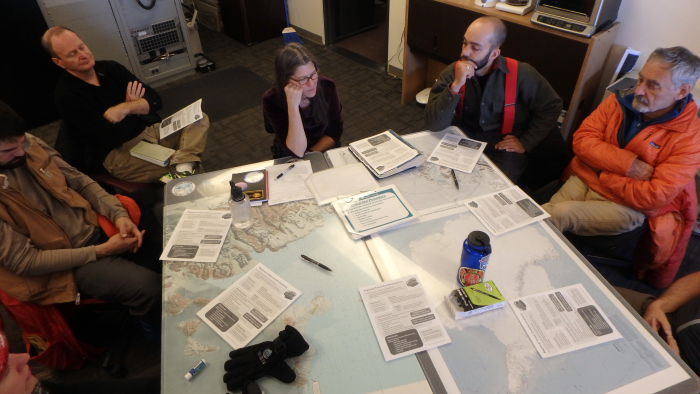 Many details were discussed during crew planning meetings
Many details were discussed during crew planning meetings
This was to be the last year of a four-year research project that had incorporated field observations, satellite remote sensing, and modeling in order to better understand the formation and behavior of crevasses forming in the SZ. Data would be collected via ground penetrating radar (GPR) pulled on sleds on 4-wheeled robots developed at Dartmouth and CRREL, GPS surveys, and new this year, geophones would be installed to detect seismic waves moving the ice self. I met the team for the first time in Sydney on our way to New Zealand and felt an enormous sense of relief at how excited they were to have me, the outsider, welcomed into their small group. The lead graduate student, Lynn Kaluzienski, and her graduate advisor and Principal Investigator, Gordon Hamilton, would be my guides during this process and I immediately felt a close bond with them as I worked to understand what we would be doing and how best to explain this important research to my students and others.
After arriving in McMurdo the team worked to get ready for the field with the robot crew, Dartmouth graduate students Ben and Josh, along with Jim, a researcher from CRREL, awaiting the arrival of their two robots, Scotty and Yeti, as that cargo completed a long and circuitous journey by plane, truck and boat from New Hampshire.
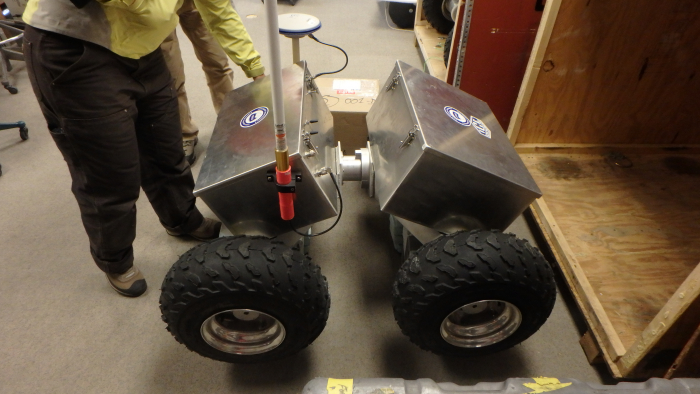 Despite being the last one into the prep room, Scotty the robot makes his appearance and rapidly draws everyone in.
Despite being the last one into the prep room, Scotty the robot makes his appearance and rapidly draws everyone in.
The two robots were semi-articulated (meaning they could rotate partially around their center) and were both battery-powered and solar-powered. The robots themselves evolved over the years and this was Scotty’s first go on the ice. They would be pulling GPR equipment into areas of the Shear Zone that were not safe for us to be traveling in due to the presence of crevasses both known and unknown.
It was during this time that I gained a better handle on the science that we would be doing in the field. Working with Lynn and Gordon to understand the complex interactions of the two ice shelves (Ross and McMurdo) in the Shear Zone while also coming to grips with how the data being collected would contribute to the understanding of this jumbled area.
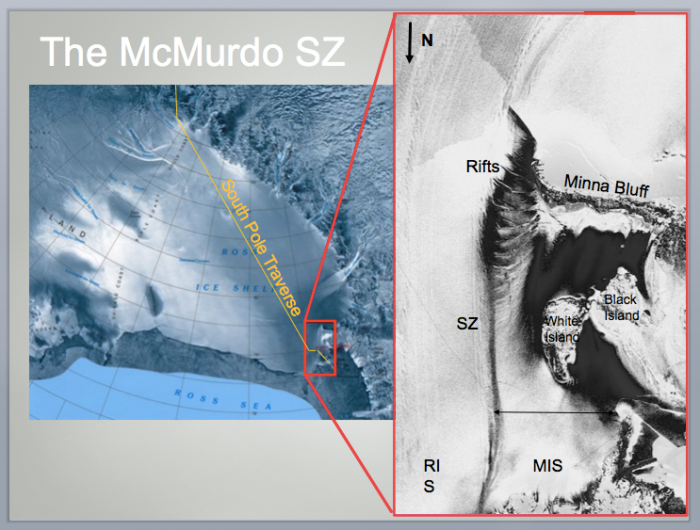 Shear Zone Camp and the major geographical features around the area
Shear Zone Camp and the major geographical features around the area
Lynn was also doing outreach with the Follow a Researcher (FAR) program from the University of Maine so we were collectively reaching out to students throughout the United States. It was exciting to be working with Lynn and sharing my own experience with students while she shared with me her experiences as a researcher both here in Antarctica and elsewhere. Getting the expedition ready to go was no easy task but the process of learning new skills, prepping gear, packing food, and testing equipment built a connection in the team that would serve us well in the field.
During the time out on the ice, we worked to get everything ready set to collect data. One team of Ben, Josh, and Jim got the robots ready to operate, while another team of myself, Lynn, Gordon, and our mountaineer Peter worked to install geophones at sites that Lynn had preselected in order to capture seismic waves moving through the ice shelf as a result of explosions set off by the South Pole Traverse (SPoT) crews preparing a path through the Shear Zone for the transport of materials from McMurdo Station to Amundenson-Scott South Pole Station, as well as the rumblings of the vehicles as they moved along the completed path. It was quickly obvious that cold was a factor – not just for us, but for the equipment as well.
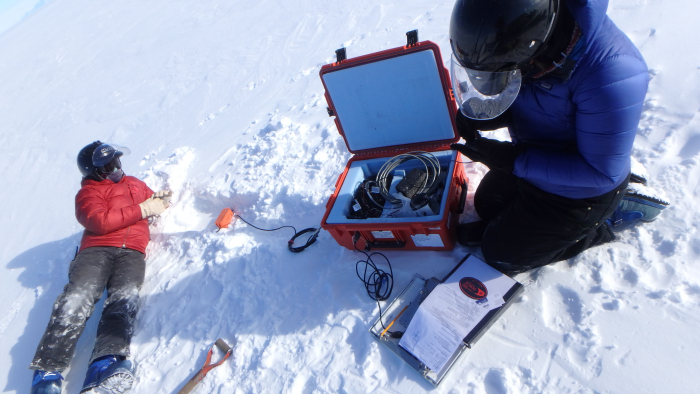 Gordon and Lynn work to install geophones out on the ice shelf.
Gordon and Lynn work to install geophones out on the ice shelf.
The main tool to get the geophones set up at each location was an iTouch who’s battery life was decreased substantially in the -15°F cold and constant, bitter wind. Work in Antarctica depends on each other and creative problem solving – with hand warmers taped to the iTouch’s and buried deep within my many layers of clothing, the battery life was enough to get the station’s installed. And this was repeated over and over, problems would arise and solutions would be created, science is not easy in the Antarctic and solutions don’t just come by running over to the local hardware store. We were on our own now and the connections forged in McMurdo during preparations made for lively and humorous evening hours in the cook tent.
After having completed the installation of geophones and an initial round of a GPS survey, tragedy befell our group when Gordon Hamilton suffered a fatal accident and we were ultimately removed from the field for the season.
I struggled with what to share this tragedy with my students – having been in near-constant communication with them via satellite phone, Twitter, and journals they were understandably concerned. Now was my moment to be a teacher, a person to explain something that happened, to reassure and put to ease, but at the same time, I was trying to deal with it. My entire journal entry in regard to that day can be read online here but I’ll provide a portion of it here:
For my students and others, it's important for you to understand that there is risk in what Gordon and so many other scientists do every day. Working in the harsh environment of Antarctica comes with risks – some known and some unknown – and the National Science Foundation (NSF) along with the United States Antarctic Program (USAP) do everything they can to minimize the risks for the scientists. If you have been reading my blog you are well aware of the number of trainings that we undertook prior to going out into the field (and there were still more that I didn't write about), all with the intention of keeping us safe and reducing risk. In addition to that, add in our collective experience on and around glaciers, crevasses, and cold environments, and the risk is further reduced.
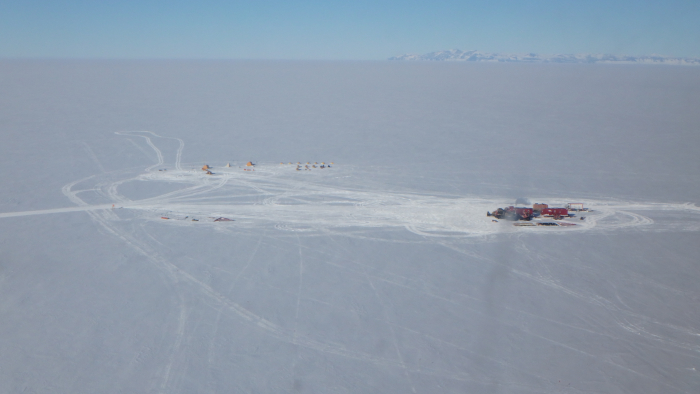 The teams camps on the ice. The left camp in the photo was Gordon's camp with the SPOT crews camp to the right.
The teams camps on the ice. The left camp in the photo was Gordon's camp with the SPOT crews camp to the right.
There is risk in our daily lives – even if you are not in Antarctica. We do a great many things to reduce the risks that you may encounter (knowingly and unknowingly) every day. For example, in a car, there are seat belts, airbags, bumpers, crumple zones, and reinforcements, all designed to minimize the risk of injury if you are involved in an accident. These safety devices do not however remove risk, they merely reduce it. When you get into the car you accept those risks and for the grand majority of the time, all of your training and those of the drivers around you contribute to the safety of all – but accidents do happen.
What happened on Saturday this past week was a horrible accident and we are all still dealing with the outcomes of that. But it was an accident. Gordon, along with all of the team, prepared and practiced how to avoid accidents and minimize risk – but as was the case on Saturday, you cannot be 100% protected. Kelly Falkner, the director of the National Science Foundation’s Division of Polar Programs, summed this up in a statement in regard to the accident, “The death of one of our colleagues is a tragic reminder of the risks we all face — no matter how hard we work at mitigating those risks — in field research.”. The NSF along with USAP has already begun to investigate this accident and may or may not propose additional safety measures if necessary to reduce risk further with the full understanding that all risk cannot be removed.
The untimely passing of Gordon still remains with me and continues to impact me in unexpected ways at unexpected times. Reflecting on my experience in Antarctica is overshadowed by the loss of Gordon.
More than anything, however, I would go back – I would go back to Antarctica, to continue to research, to continue to explore, and to honor Gordon. I made a commitment to him and our team that I will uphold. It is not known as of yet if the team will return to Antarctica next season to continue the research and although I cannot join them this time, I will still be there, communicating about the science and research and the amazing people that work together to make the United States Antarctic Program work.
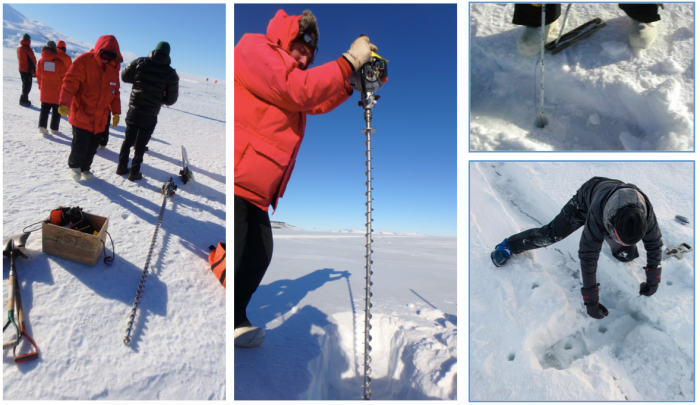 Drills with long sectional bits are used to drill through the ice so that ice thickness can be measured accurately.
Drills with long sectional bits are used to drill through the ice so that ice thickness can be measured accurately.
Gordon was passionate about getting his research out there and the importance of it understood by all – this is the role of the teacher and I was and am excited to serve in that capacity. The research that is done in the Antarctic impacts us in what we may consider to be unexpected ways, for the researchers getting this knowledge out to the greater public is vital and having a teacher on a research expedition allows for the flow of that research into the general public. One of the strengths of a teacher is the ability to communicate complicated concepts to a wide range of individuals, young and old. By combining the skills of seasoned and experienced researchers with that of skilled teachers, current science can be used in the classroom and experiences made real for students.
Now that I’m back in Colorado some things have become evident as I have spent time reflecting on my time in Antarctica:
• Science isn’t always straightforward – it requires a broad range of knowledge which rarely comes from one individual, it requires a team working towards a common goal. • Data collection in the classroom is pretty dull, data collection in the real-world is so much more. The level of preparation to collect data is a process all unto itself. • Experiments evolve over time as more data is collected and analyzed more questions arise. Those questions may lead to a better understanding of the initial question. Geophones were installed this year to better understand the dynamics that were occurring at depth in the ice sheet. They were installed due to features observed through GPR in previous years and the questions that they raised. • There is risk in everything that we do, and although that risk can be mitigated it cannot be removed – in the end, accidents do happen. • Conducting an investigation is only a part of the larger whole when working in Antarctica (or in any remote environment) – logistics of moving equipment and people in a challenge that needs to be worked out and often involves the construction of specialized equipment to succeed.
Throughout the school year, I’m incorporating the science and experience into my classroom in three current and proposed ways (the number will likely increase as I move through the curriculum):
• Physics: Flow rate of the glaciers based on the GPS measurements of past years provided by Lynn. This is further expanded on by determining the flow rate of flubber from the designed labs. • Chemistry: Phase changes, melting, and freezing. Incorporating the types of ice and how ice is formed. • Current Scientists in the Field: Part of the experience led to my students following me as well as Lynn and Gordon in the field and doing our work. The experience was especially impactful for them because they could see how the science that was being used in the classroom, was also being used in the “real-world” – even perceived simple things that we were doing. I’m including more conversations with actual scientists (both PolarTREC and otherwise) in the curriculum to encourage engagement.
Outside of my classroom, I’m dedicated to continuing to talk about my experiences in Antarctica. Since returning, I’ve shared the experience with other classrooms in St. Vrain that have been following me and have scheduled a presentation to the community of Longmont at large through the monthly library program. Working with the robotics team here at Timberline, we are developing a model of the two rovers that can be built elsewhere as examples of robot design and development. I have also applied and been accepted to present my experience at the 2017 NSTA Annual Convention in Long Beach, California.
This has been an experience that I will not forget for so many reasons. It was amazing to be able to return to the field as a respected and valued member of a research team. The number of experiences that I have been able to not only take back to my classroom but that have enriched my own professional development is innumerable. I look forward to continuing to work with PolarTREC to share the experiences of PolarTREC teachers and teams, my own experiences, and the power of polar sciences.
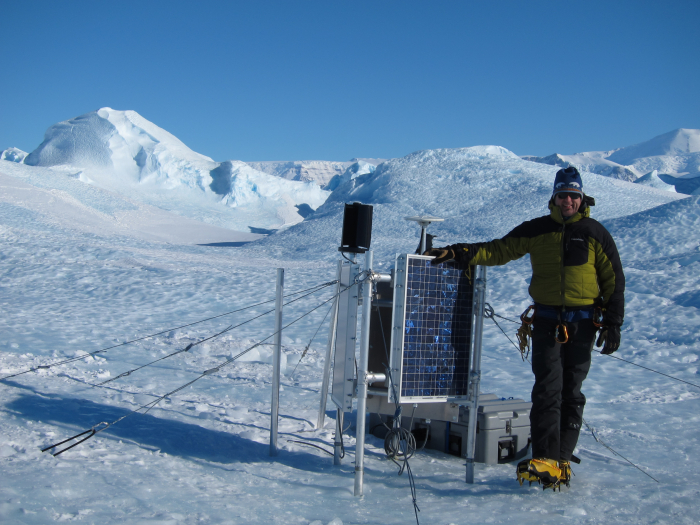 Always the adventurer, explorer, and educator - Gordon Hamilton was at home in the icy locations of our planet. He remains in our thoughts.
Always the adventurer, explorer, and educator - Gordon Hamilton was at home in the icy locations of our planet. He remains in our thoughts.| Attachment | Size |
|---|---|
| Thesenga_STEM Report.pdf3.51 MB | 3.51 MB |
